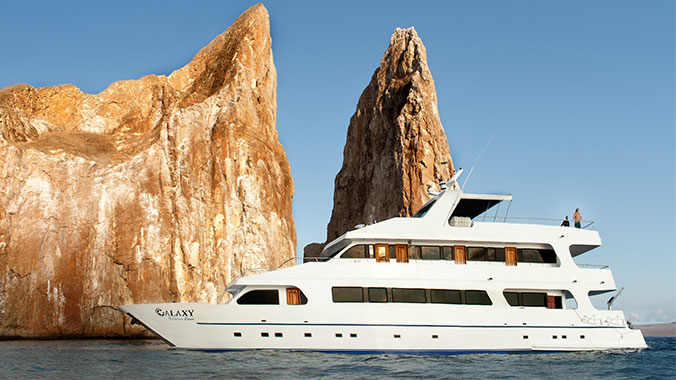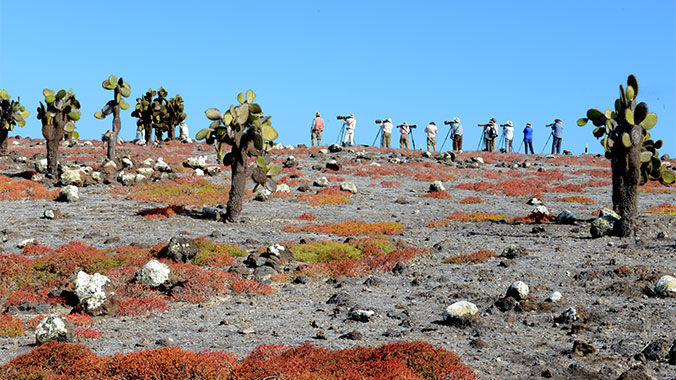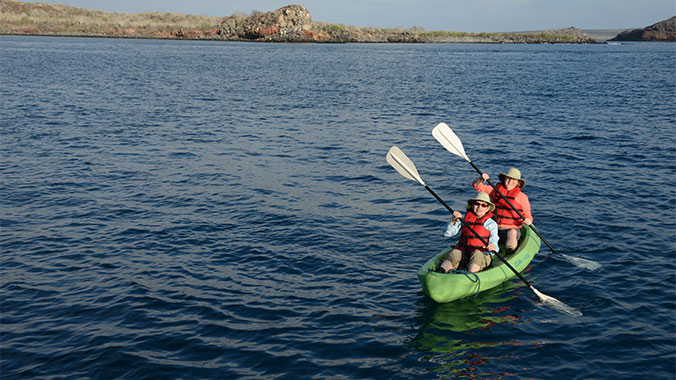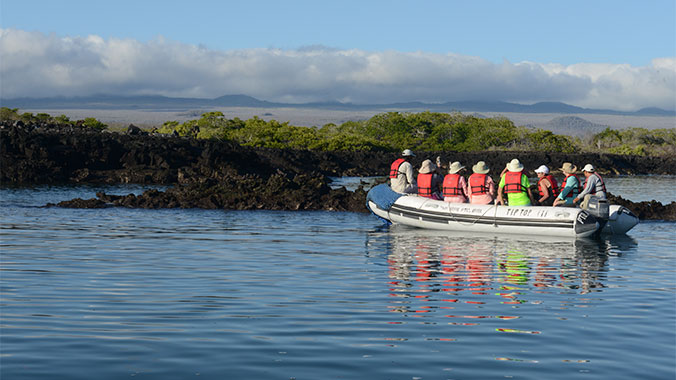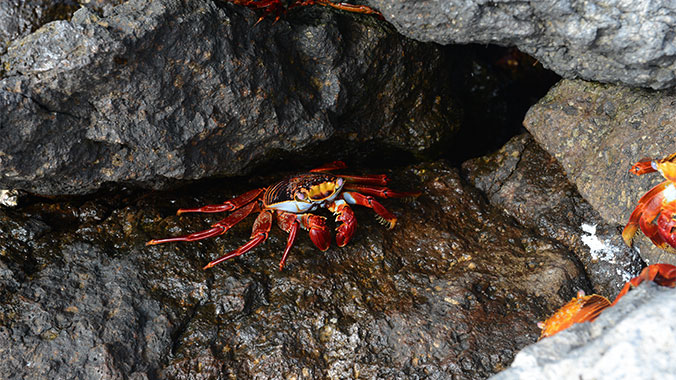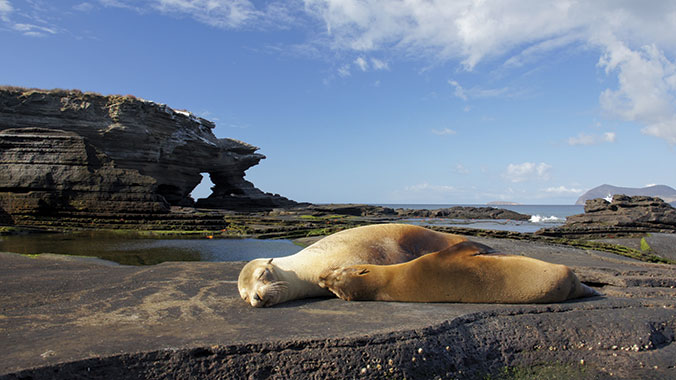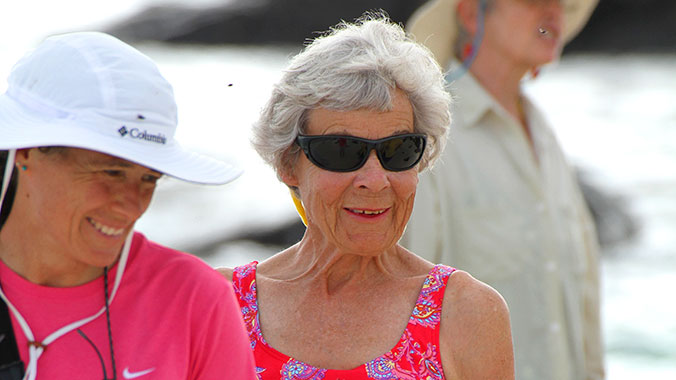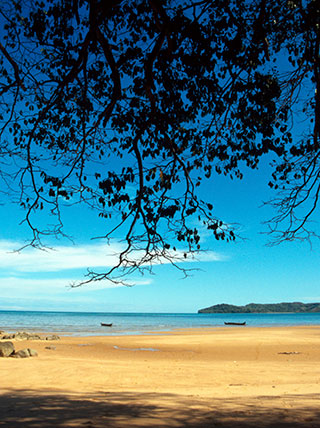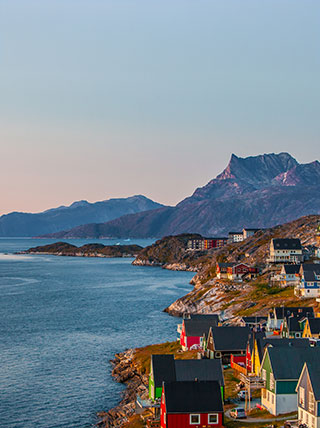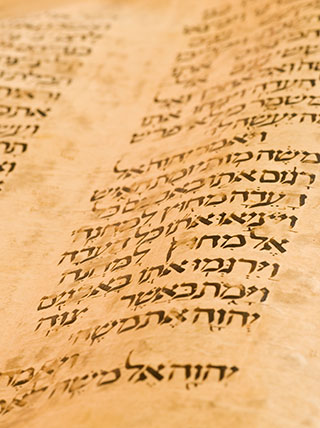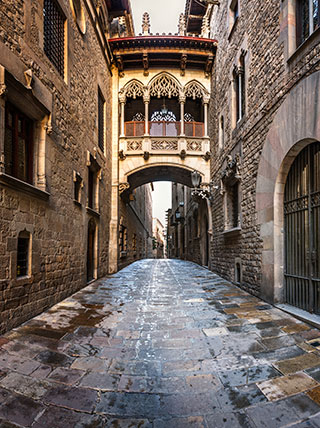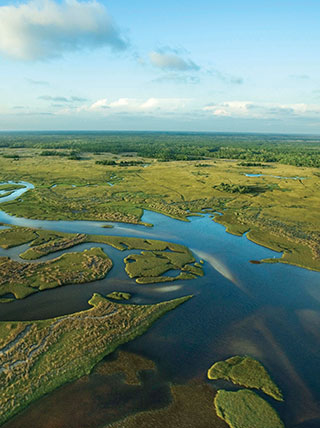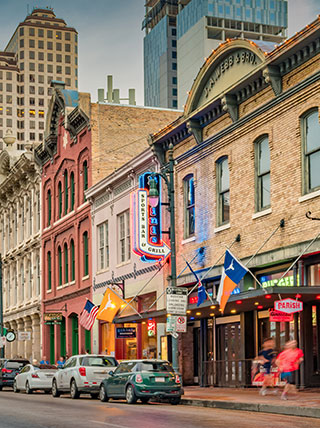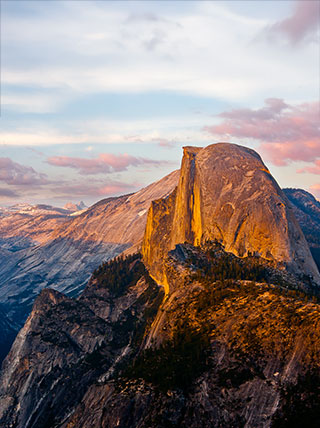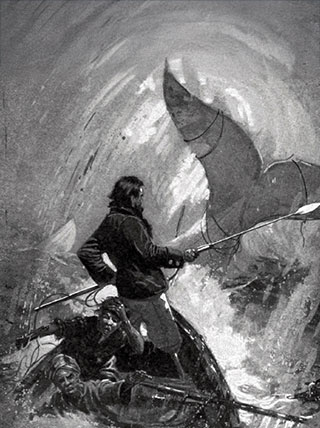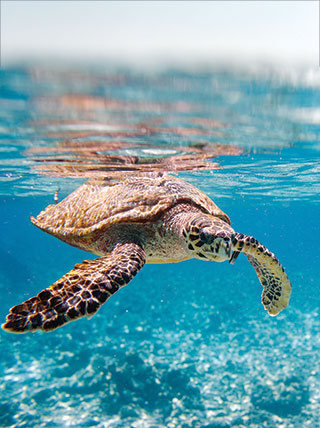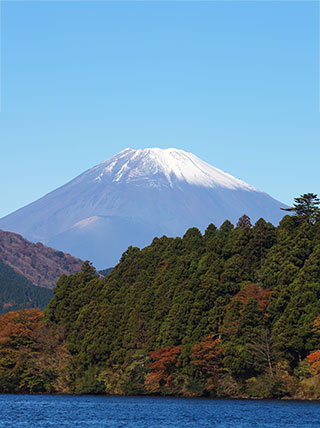Galápagos Islands, Ecuador
The Galápagos: Natural and Cultural History
Program No. 6043RJ
Gain a comprehensive understanding of the Galápagos as you learn about iconic wildlife, delicate ecosystems, volcanic activity and the science-altering legacy of Charles Darwin.
Enroll with Confidence
We want your Road Scholar learning adventure to be something to look forward to—not worry about. Learn more
Protecting the Environment
We offset a portion of the emissions created by your travel. Learn more
Itinerary
While we make every effort to ensure the accuracy of our published materials, programs are typically advertised more than a year prior to their start date.
Read More.
All itineraries and excursions are subject to change. Weather and water conditions may affect the progress of the ship, and we may miss ports if it is not safe to dock. The operators reserve the right to change the content and duration of excursions without prior notice and so the cruise itinerary should always be regarded as provisional. Whenever possible, Road Scholar’s published daily schedule will indicate port arrival and departure times. Prior to departure, if there is a major change, we will make every effort to alert you. For less significant changes, we will update you during orientation. Thank you for your understanding.
Duration
11 days
10 nights
What's Included
27 meals (
10B, 8L, 9D
)
3 expert-led lectures
16 expert-led field trips
2 flights during the program
An experienced Group Leader
10 nights of accommodations
Taxes and customary gratuity
Road Scholar Assurance Plan
Day
1
In Transit to Program, Arrive to Quito
Location:
Quito
Stay:
Sheraton Quito Hotel
Activity Note
Quito elevation: 9,223 ft - 9,883 ft. To minimize your chances of experiencing altitude sickness while in Quito, try to get plenty of rest before you travel, stay hydrated, avoid alcohol and fatty foods, consume high carbohydrate foods, and avoid strenuous exercise at high elevations. Hotel check in from 3:00 p.m. Remember to bring your nametag (sent previously).
Evening:
At leisure. Settle in and get a good night’s rest for the day ahead.
Day
2
Orientation to Quito, UNESCO World Heritage Site
Location:
Quito
Meals:
B,L,D
Stay:
Sheraton Quito Hotel
Activity Note
Getting on/off a bus; driving about 15 miles, approximately 1.5 riding time. Walking approximately 1.5 miles; mostly flat terrain, some steps. Layered clothing and comfortable walking shoes suggested for today's activities. This leisurely-paced day in Quito is very important as it will give the group time to acclimate to highland elevations.
Breakfast:
At the hotel.
Morning:
8:00 a.m. Orientation: The Group Leader will greet everyone and lead introductions. We'll review the up-to-date program schedule and any changes, discuss roles and responsibilities, logistics, safety guidelines, emergency procedures, and answer questions. Periods labeled “Free Time” and “At Leisure” offer opportunities to make the program more meaningful and memorable while going out to explore on your own, engaging in available activities independently, making new friends among fellow Road Scholars, or simply relaxing. The Group Leader will always be happy to offer suggestions. Meals on our program feature local cuisine. Program activities, schedules, personnel, and indicated distances or times may change due to local circumstances/conditions. In the event of changes, we will alert you as quickly as possible. Thank you for your understanding. We will start our day with a visit to the Iñaquito Market, where we will see first-hand the abundant natural resources Ecuador has, including the great variety of fruits, vegetables, and fish plus many more natural products used in traditional medicine in the Andes. Afterwards we'll ride to the center of the city for an orientation to Ecuador’s capital. We'll accompany the Group Leader in a walking exploration of the historic UNESCO World Heritage Site, learning about Quito's history from pre-Hispanic times, through the Colonial Period, to the Republican Era. The architecture found in Quito’s historical center is a great example of the Baroque style which is a fusion of Spanish, Moorish, Flemish and Indigenous art. Our field trip will include visits to the San Francisco Church and Convent and the Plaza Grande.
Lunch:
At a local restaurant including an introduction to typical Ecuadorian food products and cuisine.
Afternoon:
After lunch we will ride to La Carolina Park in preparation for a visit to Quito's internationally-acclaimed Botanical Garden. Ecuador is among the world’s top 20 most biodiverse nations in both plant and animal species. We’ll learn about the country’s unique flora and the regions in which they grow as we accompany our Group Leader on a walking exploration of the gardens. Although a few collections feature exotics from other countries, the primary focus of the exhibits is on native flora—including an extensive orchidarium and an ethnobotanical garden—that are representative of the country’s various regions. Before we return to our hotel for dinner, we'll enjoy an expert presentation on the ecosystems of Ecuador.
Dinner:
At the hotel.
Evening:
At leisure. Prepare luggage for early check out and flights to the Galápagos. This is a Road Scholar Adventures Afloat program. All routes, field trips, and excursions are subject to change as weather and sea conditions may affect the itinerary. Sea conditions could affect the progress of the ship, making it run late and sometimes miss sites because it is not safe to dock. Because of this, the cruise itinerary should always be regarded as provisional. The operators reserve the right to change the content of field trips and excursions without prior notice.
Day
3
Baltra Island, Board Boat, Mosquera Islet
Location:
Galápagos Islands
Meals:
B,L,D
Stay:
Tip Top V
Activity Note
The flight to/from the Galapagos takes approximately 2.5 hours and makes a stop in Guayaquil; passengers remain onboard during the stop. This flight allows each person to bring a 50 lb checked bag/suitcase, plus a carry on. Excess luggage can be stored at the hotel in Quito until our return. Actual cruise itinerary and islands visited are determined by the Galápagos National Park. The park reserves the right to change cruise itineraries without prior notice.
Breakfast:
Early, at the hotel.
Morning:
Hotel check out. After boarding the bus we will transfer to the airport in preparation for our flight to the Galapagos Islands. Our Quito Group Leader will assist us with check-in procedures and bid us farewell as we proceed through security and get ready to embark on our flight. Upon arrival to the Galápagos Islands we'll deplane and walk across the tarmac to the airport building and follow the arrival signs to Immigration. With passport in hand we will stop at the Immigration counter for an inspection of our travel documents before we can proceed to the baggage claim area. After collecting our luggage, we will meet our naturalist Galápagos Group Leader and board a bus that will drive us to the pier, followed by a short panga ride to the boat. Once on board, we'll take part in a welcome orientation and a safety drill as we sail to our first visitor site in the Galápagos.
Lunch:
Aboard the yacht.
Afternoon:
After lunch we will navigate a short distance to Mosquera Islet, located between Baltra and North Seymour. A wet landing will deliver us to a white sand beach in preparation for our walking explorations. From there, we’ll walk along the beach to observe resident sea lions, colorful sally lightfoot crabs and coastal birds. We'll return to the yacht and freshen up before dinner.
Dinner:
Aboard the yacht, after enjoying a welcome cocktail with the crew.
Evening:
Orientation to the next day's activities.
Day
4
Sullivan Bay, Santiago Island, Rabida Island
Location:
Galápagos Islands
Meals:
B,L,D
Stay:
Tip Top V
Activity Note
Sullivan Bay: wet landing and moderate difficulty due to rocky, volcanic terrain. Good walking shoes are a must, as the volcanic terrain is sharp and rough. Rabida Island: wet landing. Easy/moderate trail conditions due to sandy trails.
Breakfast:
Aboard the yacht.
Morning:
Wet landing at Sullivan Bay, followed by a walking field trip led by our naturalist leader. During this activity we'll be able to get a good look at the island's unique geological features. Santiago (a.k.a. San Salvador) is the fourth largest island in the Galápagos. A volcanic eruption that took place in the early 1900s formed huge lava flows in the area that is now Sullivan Bay. As the lava cooled off, it solidified into a black sheet of interesting shapes and textures that made its way to the sea. The rope-like lava seen on this island is called pahoehoe lava. Other interesting formations include lava bubbles and tree shapes, ghosts of Santiago's past. Few plant species have been able to root in this harsh environment. Although the volcanic formations on Santiago have the obvious spotlight, keep an eye out for American Oystercatchers nesting along the coast (July) and Galápagos Hawks performing their acrobatic courtship rituals (August). We will have the opportunity to swim and snorkel before returning the yacht.
Lunch:
Aboard the yacht.
Afternoon:
This afternoon we will make a wet landing at Rabida Island. Our naturalist leader will point out the island's unique flora and fauna during a walking exploration of the beach and local trails. Rabida (Jervis) has a dark red beach favored by sea lions and nesting pelicans. A salt water lagoon located a small distance from the beach is home to flamingoes and the occasional White-cheeked Pintail. Palo santo trees cover the island's volcanic peak, which can be seen from a short trail (approximately a .5 mile walk). Some of the Galápagos' rarest bird species are here in abundance, including Large-billed Flycatchers, Galápagos Hawks and nine varieties of finches. After optional swimming and snorkeling opportunities we will head back to the yacht.
Dinner:
Aboard the yacht.
Evening:
Enjoy an expert presentation by our naturalist Group Leader, followed by an orientation to the next day's activities. (Please note that the day/time of lectures is subject to change).
Day
5
Punta Espinoza, Fernandina, Elizabeth Bay, Isabela Island
Location:
Galápagos Islands
Meals:
B,L,D
Stay:
Tip Top V
Activity Note
Punta Espinoza: dry landing, moderate trail conditions due to slippery rocks at low tide and uneven terrain. Good walking shoes are a must for the 1.2 mile walk on sharp volcanic rocks. Elizabeth Bay: about a 2-hour panga ride along mangroves and islets.
Breakfast:
Aboard the yacht.
Morning:
We’ll make a dry landing at Punta Espinoza and then walk on local trails in search of the resident sea lion colony and Flightless Cormorant nesting sites. Fernandina has some of the most dramatic landscapes found in the archipelago and is also one of the best places to see the lava cactus. The aa and pahoehoe lava formations create a unique landscape and provide visitors with a great chance to study lava flows and the forces which gave birth to the Galápagos Islands. We will have the opportunity to swim and snorkel before returning the yacht.
Lunch:
Aboard the yacht.
Afternoon:
This afternoon we will enjoy a panga ride in and around the mangroves and islets of Elizabeth Bay to look for shore birds, marine turtles, rays, sea lions, and more. Return to the yacht.
Dinner:
Aboard the yacht.
Evening:
Orientation to the next day's activities.
Day
6
Urbina Bay, Tagus Cove, Isabela Island
Location:
Galápagos Islands
Meals:
B,L,D
Stay:
Tip Top V
Activity Note
Urbina Bay: strong waves can make disembarkation tricky at this site. Use a zip-lock bag to protect cameras and binoculars from splashes during the wet landing. Please take steps to remain hydrated during this approximately 2-mile hike. Tagus Cove: panga ride.
Breakfast:
Aboard the yacht.
Morning:
After breakfast we will make a wet landing at Urbina Bay and begin our walking exploration of this unique site. Urbina Bay is situated approximately two fifths of the way along Isabela’s western coast. The flattened area of the bay exhibits signs of a coral reef on land; proof that the flat land we see today in that area was once uplifted from the sea. Cormorants, pelicans, marine iguanas, and Flightless Cormorants frequent this site in addition to marine turtles and rays which are sometimes seen swimming in the bay. Opportunity for swimming and snorkeling before returning to the yacht in time for lunch.
Lunch:
Aboard the yacht.
Afternoon:
We’ll join our naturalist group leader on a panga ride to Tagus Cove on Isabela Island to examine historic graffiti left behind by sailors--some dating as far back as the 1830s. We will also look for Galapagos Penguins, marine iguanas, sea lions and a variety of birds including boobies and Flightless Cormorants. Opportunity for swimming, snorkeling, and/or kayaking before returning to the yacht.
Dinner:
Aboard the yacht.
Evening:
Enjoy an expert presentation by our naturalist Group Leader, followed by an orientation to the next day's activities. (Please note that the day/time of lectures is subject to change).
Day
7
Puerto Egas, Santiago Island, Bartolome Island
Location:
Galápagos Islands
Meals:
B,L,D
Stay:
Tip Top V
Activity Note
Puerto Egas: wet landing and easy to moderate walking conditions. Bartolome: dry landing. The 1.2-mile walk to the top of the volcano includes a climb up a long wooden staircase (375 steps) with railings.
Breakfast:
Aboard the yacht.
Morning:
A short panga ride will take us to Santiago Island in preparation for a wet landing at Puerto Egas' black sand beach. As we explore local trails, our naturalist leader will help to point out local wildlife. Puerto Egas, located on the northwestern side of Santiago Island, has black volcanic formations that provide shelter to a number of creatures. Here it is possible to see marine iguanas sunning themselves on the rocks while sea birds fly overhead in search of food. Brightly colored Sally Lightfoot crabs live in the rock crevices and tide pools; a sharp contrast to the black lava formations they call home. Galápagos fur seals enjoy the inlets along the western shoreline and have been known to swim with visitors from time to time. Opportunity for swimming and snorkeling before returning to the yacht.
Lunch:
Aboard the yacht.
Afternoon:
Dry landing at Bartolomé Island. After disembarkation we will accompany our naturalist leader on a hike up Escalera Hill. On Bartolomé Island we will be able to view volcanic formations such as lava bombs, spatter, and cinder cones. From the summit it is possible to see surrounding islands as well as Pinnacle Rock's eroded tuff cone. On the way to the summit, watch for colonies of marine iguanas, lava lizards, tiquilla and various cacti. Bartolomé is one of the best places to find Galápagos penguins. Opportunity for swimming and snorkeling. Return to the yacht.
Dinner:
Aboard the yacht.
Evening:
Orientation to the next day's activities.
Day
8
Sombrero Chino, Dragon Hill, Santa Cruz Island
Location:
Galápagos Islands
Meals:
B,L,D
Stay:
Tip Top V
Activity Note
Sombrero Chino: wet/ dry landing (depending on local weather conditions). Cerro Dragon: moderate walking conditions due to rocky, volcanic beach.
Breakfast:
Aboard the yacht.
Morning:
We will start the day by navigating around Sombrero Chino to observe its resident wildlife and lava formations. Depending on the weather conditions, we may also make a wet or dry landing and undertake a short hike around the island. This small island can be seen a short distance from Santiago Island’s southeastern tip. The name, meaning Chinese hat, describes the volcanic cone’s unique shape. A cove on the northern side of the island offers good conditions for swimming, snorkeling and kayaking; it is also a favored sea lion hangout. Other species frequently seen in and around the island include American Oystercatchers, Brown Noddys, Galápagos Hawks, Sally Lightfoot crabs, spotted eagle rays, whitetip reef sharks, Galápagos Penguins, marine iguanas, Lava Herons, lava lizards, and Brown Pelicans. We'll have an opportunity to swim, snorkel or kayak before returning to the yacht.
Lunch:
Aboard the yacht.
Afternoon:
After a panga ride and a dry landing, we will initiate our walk to the lookout point on Cerro Dragon (Dragon Hill), Santa Cruz. In the 1970s, the site was known for its colony of land iguanas. Flamingoes and shorebirds seasonally visit the lagoons in search of shrimp, appearing in larger numbers during the dryer season when the crustaceans are more plentiful. The rocky beach provides good snorkeling opportunities when the tide is high.
Dinner:
Aboard the yacht.
Evening:
Orientation to the next day's activities.
Day
9
Santa Cruz Highlands, Wild Tortoises, Charles Darwin Station
Location:
Galápagos Islands
Meals:
B,L,D
Stay:
Tip Top V
Activity Note
Santa Cruz Highlands: dry landing and moderate to difficult trail conditions due to rocky, uneven (and possibly muddy) trails. Driving approximately 2 hours throughout the day.
Breakfast:
Aboard the yacht.
Morning:
We will tender ashore to Santa Cruz Island then, board a bus that will take us into the highlands. Our naturalist will lead us on a walking field trip on grassy trails in search of giant tortoises living in the wild. We'll learn more about their diet, breeding habits and overall biology as we observe them in their natural habitat. In addition to giant tortoises, Santa Cruz is home to several species of Darwin's finches as well as Yellow Warblers, Galápagos Rails and Paint-billed Crakes. A dramatic change in vegetation zones can be seen as one travels into the highland region of the island.
Lunch:
At a local ranch in the highlands.
Afternoon:
Our bus will deliver us to Puerto Ayora in preparation for our field trip to the Fausto Llerena Interpretation Center located at the Charles Darwin Research Station. Our naturalist will lead us on foot through the facility and introduce us to the station's mission and its tortoise breeding projects. The Charles Darwin Research Station (CDRS) is a biological research station based on Santa Cruz Island and operated by the Charles Darwin Foundation. The organization plays an important role in scientific research, environmental education, and conservation efforts in the islands. The station conducts its projects with the help of a large team of scientists, educators, volunteers, research students and support staff from all over the world. Late afternoon return to the yacht.
Dinner:
Aboard the yacht.
Evening:
Orientation of next day's activities. Prepare luggage for final disembarkation.
Day
10
North Seymour, Flight to Quito
Location:
Quito
Meals:
B,D
Stay:
Hosteria Rincon de Puembo
Activity Note
Flight to Quito takes approximately 2.5 hours. Participants with international flights departing very late this evening/before dawn next morning will check out of the hotel after dinner, then transfer to the international airport in preparation for airline check in. Due to limited flight times from the Galápagos to Quito, the timing between the farewell dinner and the transfer afterwards to the airport can be diminutive. See “Program Notes” section for more details regarding departure options.
Breakfast:
Aboard the yacht.
Morning:
Early this morning we will make a dry landing on North Seymour Island to enjoy a 1.5-mile walk on local trails. North Seymour Island is conveniently located next to Baltra Island. The island has a major nesting colony of Blue-footed Boobies and Magnificent Frigatebirds. During April-May the Blue-footed Boobies can be spotted performing their comical mating dance. Blue-footed Boobies oftentimes nest very near the trails, giving visitors the opportunity to get a closer view during the walks. From August-November sea lions are giving birth and it is possible to view pups of all sizes. Just remember to stay at a safe distance as females tend to be very protective of their young. A walk near known iguana nesting sites offers a good opportunity to view marine iguanas and land iguanas. Besides boasting abundant fauna, North Seymour Island is dotted with the endemic Palo Santo tree (Bursera graveolens). Upon our return to the yacht, we will set sail to Baltra Island in preparation for the flight to Quito. From the pier we will board a bus to the airport, where we will bid farewell to our Galápagos Group Leader and the Islas Encantadas. The flight to Quito makes a stop in Guayaquil; passengers remain on board.
Lunch:
On your own, at the airport. Sandwiches, empanadas and snacks are available for purchase after going through security.
Afternoon:
Late afternoon arrival in Quito. We'll board a bus to our hotel and check in, followed by free time to finish packing or relax before joining the rest of the group for dinner.
Dinner:
At the hotel. During a farewell dinner, share your favorite experiences with new Road Scholar friends.
Evening:
At leisure. Prepare for check out and international flights to North America. Participants with international flights departing very late this evening/before dawn next morning will check out of the hotel and transfer to the Mariscal Sucre International Airport (UIO) in preparation for airline check in.
Day
11
Program Concludes, In Transit from Program
Location:
In Flight
Meals:
B
Activity Note
Hotel check out by 11:00 a.m. See your program's "Getting There" information regarding transfers.
Breakfast:
At the hotel (dependent on flight times). This concludes the program.
Morning:
If you are returning home, safe travels. If you are staying on independently, have a wonderful time. If you are transferring to another Road Scholar program, detailed instructions are included in your Information Packet for that program. We hope you enjoy Road Scholar learning adventures and look forward to having you on another rewarding program in the future. Don’t forget to like our Facebook page and follow us on Instagram. Best wishes for all your journeys!
Please Note:
This program has itinerary variations on certain dates.
Dec 09, 2026 - Dec 19, 2026
Jul 21, 2025 - Jul 31, 2025
Aug 15, 2025 - Aug 25, 2025
Sep 10, 2025 - Sep 20, 2025
Sep 24, 2025 - Oct 04, 2025
Oct 08, 2025 - Oct 18, 2025
Oct 24, 2025 - Nov 03, 2025
Oct 29, 2025 - Nov 08, 2025
Nov 10, 2025 - Nov 20, 2025
Nov 12, 2025 - Nov 22, 2025
Nov 24, 2025 - Dec 04, 2025
Dec 03, 2025 - Dec 13, 2025
Dec 08, 2025 - Dec 18, 2025
Dec 10, 2025 - Dec 20, 2025
Jan 05, 2026 - Jan 15, 2026
Jan 07, 2026 - Jan 17, 2026
Jan 21, 2026 - Jan 31, 2026
Feb 02, 2026 - Feb 12, 2026
Feb 18, 2026 - Feb 28, 2026
Feb 25, 2026 - Mar 07, 2026
Mar 02, 2026 - Mar 12, 2026
Mar 11, 2026 - Mar 21, 2026
Mar 25, 2026 - Apr 04, 2026
Mar 30, 2026 - Apr 09, 2026
Apr 01, 2026 - Apr 11, 2026
Apr 04, 2026 - Apr 14, 2026
Apr 15, 2026 - Apr 25, 2026
Apr 22, 2026 - May 02, 2026
May 13, 2026 - May 23, 2026
Jun 10, 2026 - Jun 20, 2026
Jul 29, 2026 - Aug 08, 2026
Aug 19, 2026 - Aug 29, 2026
Sep 16, 2026 - Sep 26, 2026
Oct 14, 2026 - Oct 24, 2026
Nov 11, 2026 - Nov 21, 2026
Dec 09, 2026 - Dec 19, 2026
Dec 9 - Dec 19, 2026 Itinerary Differences:
This program date sails on the Tip Top V. Cruise Itinerary varies by date. Actual cruise itinerary and islands visited are assigned by the Galapágos National Park and can be changed without prior notice.


